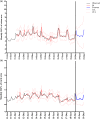Epidemiological features and time-series analysis of influenza incidence in urban and rural areas of Shenyang, China, 2010-2018
- PMID: 32054544
- PMCID: PMC7026897
- DOI: 10.1017/S0950268820000151
Epidemiological features and time-series analysis of influenza incidence in urban and rural areas of Shenyang, China, 2010-2018
Abstract
In recent years, there have been a significant influenza activity and emerging influenza strains in China, resulting in an increasing number of influenza virus infections and leading to public health concerns. The aims of this study were to identify the epidemiological and aetiological characteristics of influenza and establish seasonal autoregressive integrated moving average (SARIMA) models for forecasting the percentage of visits for influenza-like illness (ILI%) in urban and rural areas of Shenyang. Influenza surveillance data were obtained for ILI cases and influenza virus positivity from 18 sentinel hospitals. The SARIMA models were constructed to predict ILI% for January-December 2019. During 2010-2018, the influenza activity was higher in urban than in rural areas. The age distribution of ILI cases showed the highest rate in young children aged 0-4 years. Seasonal A/H3N2, influenza B virus and pandemic A/H1N1 continuously co-circulated in winter and spring seasons. In addition, the SARIMA (0, 1, 0) (0, 1, 2)12 model for the urban area and the SARIMA (1, 1, 1) (1, 1, 0)12 model for the rural area were appropriate for predicting influenza incidence. Our findings suggested that there were regional and seasonal distinctions of ILI activity in Shenyang. A co-epidemic pattern of influenza strains was evident in terms of seasonal influenza activity. Young children were more susceptible to influenza virus infection than adults. These results provide a reference for future influenza prevention and control strategies in the study area.
Keywords: Influenza strains; influenza-like illness; seasonal distinctions; surveillance.
Figures





Similar articles
-
Understanding the complex seasonality of seasonal influenza A and B virus transmission: Evidence from six years of surveillance data in Shanghai, China.Int J Infect Dis. 2019 Apr;81:57-65. doi: 10.1016/j.ijid.2019.01.027. Epub 2019 Jan 23. Int J Infect Dis. 2019. PMID: 30684745
-
Epidemiology and impact of influenza in Mongolia, 2007-2012.Influenza Other Respir Viruses. 2014 Sep;8(5):530-7. doi: 10.1111/irv.12268. Epub 2014 Jul 9. Influenza Other Respir Viruses. 2014. PMID: 25043147 Free PMC article.
-
Epidemiology and viral etiology of the influenza-like illness in corsica during the 2012-2013 Winter: an analysis of several sentinel surveillance systems.PLoS One. 2014 Jun 24;9(6):e100388. doi: 10.1371/journal.pone.0100388. eCollection 2014. PLoS One. 2014. PMID: 24959929 Free PMC article.
-
Lessons from 40 years' surveillance of influenza in England and Wales.Epidemiol Infect. 2008 Jul;136(7):866-75. doi: 10.1017/S0950268807009910. Epub 2007 Nov 30. Epidemiol Infect. 2008. PMID: 18047750 Free PMC article. Review.
-
Harmonizing influenza primary-care surveillance in the United Kingdom: piloting two methods to assess the timing and intensity of the seasonal epidemic across several general practice-based surveillance schemes.Epidemiol Infect. 2015 Jan;143(1):1-12. doi: 10.1017/S0950268814001757. Epub 2014 Jul 15. Epidemiol Infect. 2015. PMID: 25023603 Free PMC article. Review.
Cited by
-
The Efficacious Benefit of 25-Hydroxy Vitamin D to Prevent COVID-19: An In-Silico Study Targeting SARS-CoV-2 Spike Protein.Nutrients. 2022 Nov 23;14(23):4964. doi: 10.3390/nu14234964. Nutrients. 2022. PMID: 36500994 Free PMC article.
-
Serum Calcium and Vitamin D levels: Correlation with severity of COVID-19 in hospitalized patients in Royal Hospital, Oman.Int J Infect Dis. 2021 Jun;107:153-163. doi: 10.1016/j.ijid.2021.04.050. Epub 2021 Apr 20. Int J Infect Dis. 2021. PMID: 33892191 Free PMC article.
-
Forecasting waved daily COVID-19 death count series with a novel combination of segmented Poisson model and ARIMA models.J Appl Stat. 2021 Oct 12;50(11-12):2561-2574. doi: 10.1080/02664763.2021.1976119. eCollection 2023. J Appl Stat. 2021. PMID: 37529559 Free PMC article.
-
Forecasting COVID-19 Confirmed Cases Using Empirical Data Analysis in Korea.Healthcare (Basel). 2021 Mar 1;9(3):254. doi: 10.3390/healthcare9030254. Healthcare (Basel). 2021. PMID: 33804380 Free PMC article.
-
Predictive Capacity of COVID-19 Test Positivity Rate.Sensors (Basel). 2021 Apr 1;21(7):2435. doi: 10.3390/s21072435. Sensors (Basel). 2021. PMID: 33916239 Free PMC article.
References
-
- Alonso WJ et al. (2007) Seasonality of influenza in Brazil: a traveling wave from the Amazon to the subtropics. American Journal of Epidemiology 165, 1434–1442. - PubMed
-
- Li-Kim-Moy J et al. (2016) Australian vaccine preventable disease epidemiological review series: influenza 2006 to 2015. Communicable Diseases Intelligence Quarterly Report 40, E482–e495. - PubMed
MeSH terms
LinkOut - more resources
Full Text Sources
Medical

